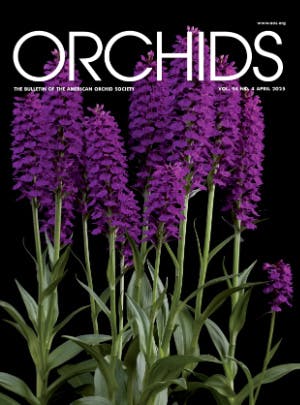
OF THE HUNDREDS of terrestrial orchid species found throughout the temperate Northern Hemisphere (northern USA, Canada and Alaska through northern Asia to Europe and even northern Africa), some of the most adaptable to the home garden are members of the genus Dactylorhiza (meaning: dactyla = finger; rhiza = root). These “finger-rooted” orchids are more frequently called “marsh orchids” because of their need for a constant source of moisture (not flooded, but certainly moist). The currently 146 species recognized today by Plants of the World Online (POWO 2025) are often divided into seven or more subgroups based on somewhat obscure differentiations, but all are beautiful and produce abundant flowers.
[1] Dactylorhyza maculata subsp. fuchsii with its spotted foliage naturalized in the author’s backyard in Oregon. Photograph by the author.

Given the essentially worldwide range of the genus, it should be no surprise that there are some important cultural differences among the species. The grower should always investigate, especially given that some species may benefit from the addition of calcareous materials, providing a higher base pH, and others prefer lower, more acidic conditions. This is a prolific genus that naturally and easily hybridizes in the wild, which can create havoc for accurate identification.
Most species are believed to be pollinated by marsh flies, tiny Diptera types that frequent the often boggy-like conditions where Dactylorhiza are found. While only four species of Dactylorhiza are reportedly fragrant to humans, they most likely all produce pheromones that smell faintly like carrion, which the marsh flies find attractive.
[2] Dactylorhiza majalis with the major floral parts labeled for reference.

Singular unbranched but densely flowered inflorescences to 3 feet (1 m) surrounded by attractive basal leaves emerge in the spring from the top of the largest bulb. Many of the species have attractively purple-spotted foliage that visually anchors the upright inflorescence. Although the individual flowers may be less than 1 inch (2.5 cm) wide, they are abundant, with as many as 40 or more densely arrayed on each upright spike. All can form impressive floriferous clumps whether grown in pots or naturalized in the garden. Flowers range in color from light lavender with various spotted and striped purple markings to fully saturated pink to purple.
Dactylorhiza was, for many years, considered part of the genus Orchis, but more recently have been broken out as a separate genus based primarily on the palmate or tapering, fingerlike shape of the tubers, distinctive from the genus Orchis. Like many of the terrestrial orchids of Europe, legends emerged to explain and apply their shapes according to the “doctrine of signatures,” which ascribes medicinal benefit applications based on the shape of the plant. Plant parts that resemble, in shape, various organs of the human body were often prescribed to treat associated maladies. Most famous historically is the use of the tubers of the genus Orchis to treat issues of masculinity and male fertility. Similarly, it was believed that the tubers of Dactylorhiza, if taken on the morning of Saint John’s Eve (about June 24) and planted at the home’s threshold the same day, the “evil eye” could be avoided as well as perhaps other witches’ spells.
Although not commonly seen for sale at orchid shows, multiple sources can be found by searching online. Something new for the determined orchid grower!
[3] Dactylorhiza purpurella ‘Mello Spirit’ CHM/AOS produced 64 flowers and buds on one compact inflorescence.

LIGHT LEVELS In the outdoor garden, Dactylorhiza thrive in the sunny morning but also need afternoon lightly shaded conditions to minimize heating. Light levels and temperatures are integrally connected. Dactylorhiza can generally withstand higher light levels provided there are reduced temperatures, ample air movement and sufficient soil moisture and humidity to ameliorate the heat stress.
[4] Dactylorhiza majalis ‘Major Hot Lips’ CBR/AOS grown by Doug and Beth Martin.

TEMPERATURES The vast majority of Dactylorhiza are considered “frost tolerant” and can easily survive freezing temperatures down to 20 F (-7 C). The greater challenge appears to be their intolerance of heat, generally not thriving well in the outdoor garden when temperatures exceed 90 F (32 C) for long periods of time. Shady well-draining areas are a bonus to growing them. Growing indoors under lights is another option, but decidedly cooler temperatures will be appreciated during the winter months to simulate their natural growing conditions.
[5] Dactylorhiza maculata ‘Trident’s Centennial’ CHM/AOS grown by Wilford B. Neptune, MD.

POTTING AND WATERING Dactylorhiza prefer a well-draining medium but should be kept moist (not wet) all year, with heavier watering and fertilizer during active growth in the spring and summer. The plants should be potted or planted so that the top of the root mass is about 2–3 inches (5–7.5 cm) below the surface (a bit deeper in colder climates). If grown indoors, consider a standard terrestrial compost of seven parts small bark, one part small charcoal and one part small vermiculate to which is added nine parts of regular potting soil. When plants show signs of dormancy (leaf loss), reduce watering and temperature. Resume watering and fertilizing when new growth emerges. When grown indoors, some growers move them outdoors for the winter and plunge them into the garden or heel them in a protected area. When growth appears in the spring, they can be moved back indoors.
Whether you are fortunate enough to grow these orchids in your garden or in pots under lights or in a sunroom, where they can grow tall and provide a parade of wonderful flowers, these attractive species are certainly worthy.
[6] Inflorescences of Dactylorhiza majalis can easily surpass 10 inches (26 cm).

—Charles Wilson is the current chair of the Atlanta Judging Center who has been growing orchids for over 45 years. His special interests include Bulbophyllum, Cattleya, Coelogyne, Galeandra, Paphiopedilum, and about everything else, too. He is an active volunteer with the AOS and can be reached at zooemeritus@gmail.com.











